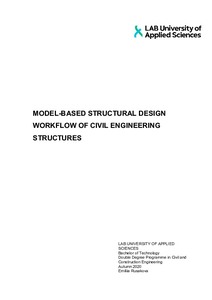Model-based structural design workflow of civil engineering structures
Rusakova, Emiliia (2020)
Lataukset:
Rusakova, Emiliia
2020
All rights reserved. This publication is copyrighted. You may download, display and print it for Your own personal use. Commercial use is prohibited.
Julkaisun pysyvä osoite on
https://urn.fi/URN:NBN:fi:amk-2020103021833
https://urn.fi/URN:NBN:fi:amk-2020103021833
Tiivistelmä
The aim of the study was to analyze the existing workflow inside Ramboll Finland bridge department. The secondary goal was to compare the current workflow with the one from a decade ago and based on this, assume what to expect in the future. The client of the thesis was design and consulting company Ramboll Finland Oy.
The first part of the study focused on the current structural design workflow for a typical project. For this purpose, several interviews with experts were conducted and research was carried out. Besides that, a study was made to identify general challenges in it. The second part, which included previous ways of designing structures, was also based on research and interviews.
As a result of the research, current workflow was examined and recommendations were made which may be useful for more detailed research in the future. There was also made a brief comparison of the software used. In addition to all of the above, some assumptions were presented about what to expect from the future workflow, as well as the progress made over previous years.
The first part of the study focused on the current structural design workflow for a typical project. For this purpose, several interviews with experts were conducted and research was carried out. Besides that, a study was made to identify general challenges in it. The second part, which included previous ways of designing structures, was also based on research and interviews.
As a result of the research, current workflow was examined and recommendations were made which may be useful for more detailed research in the future. There was also made a brief comparison of the software used. In addition to all of the above, some assumptions were presented about what to expect from the future workflow, as well as the progress made over previous years.
